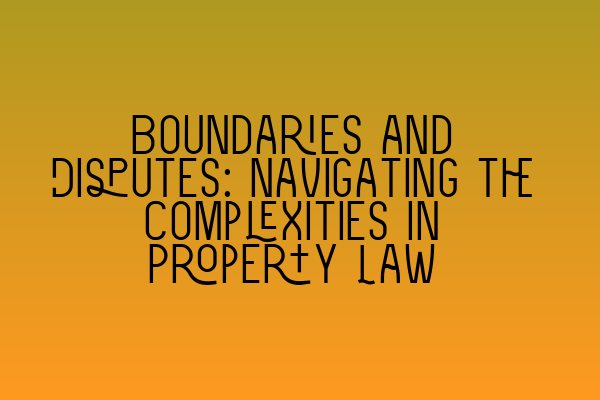Boundaries and Disputes: Navigating the Complexities in Property Law
Property law can be a tricky and complex area to navigate, especially when it comes to boundaries and disputes. From determining the exact extent of a property to resolving conflicts between neighbors, understanding the intricacies of property boundaries is essential for both property owners and legal professionals.
At SQE Property Law & Land Law, we understand the importance of providing expert guidance and advice when it comes to resolving boundary disputes. In this blog post, we will delve into the complexities of property law, explore common boundary disputes, and provide insights on how to navigate these issues effectively.
Understanding Property Boundaries
Property boundaries define the limits of a property owner’s rights and responsibilities. They mark the division between two adjoining properties and establish the rights of each owner concerning the use and enjoyment of their land. Property boundaries can be physical, such as fences or walls, or they can be legal boundaries determined by surveys and historical records.
One common misconception is that property boundaries are always fixed and cannot be changed. However, this is not always the case. Boundaries can change through agreements between neighbors, legal actions, or adverse possession. As a property owner, it is crucial to understand the legal principles and rules that govern boundary disputes.
Common Boundary Disputes
Boundary disputes can arise due to a variety of reasons, and they can quickly turn into contentious and lengthy legal battles. Some common boundary disputes include:
- Encroachment: When a neighbor’s structure, such as a fence or building, extends beyond the legal boundary and onto your property.
- Trespass: When a neighbor or third party enters your property without permission, violating your right to exclusive possession.
- Disagreements over boundary features: Disputes can arise regarding the exact location or nature of boundary features, such as walls, fences, hedges, or even trees.
- Boundary confusion: In some cases, the boundaries between properties may not be clearly defined or agreed upon, leading to disagreements and disputes.
Resolving these disputes requires a strong understanding of property law, evidence gathering, negotiation skills, and, in some cases, court proceedings. It is essential to seek professional legal advice to ensure your rights are protected and that you take the appropriate actions to resolve the dispute in the most efficient manner possible.
Navigating Boundary Disputes
When faced with a boundary dispute, there are several steps you can take to navigate the complexities of property law effectively:
- Consult with a property law expert: Seeking advice from a solicitor experienced in property law and boundary disputes is the first and most crucial step. They will assess the situation, review relevant documents and evidence, and provide you with guidance on the best course of action.
- Gather evidence: Collecting evidence is vital in strengthening your case. This can include reviewing historical records, property deeds, surveys, photographs, and witness testimonies. Your solicitor will help you identify and gather the necessary evidence.
- Engage in communication and negotiation: In many cases, boundary disputes can be resolved through open communication and negotiation with the other party. Your solicitor can act as a mediator and facilitate constructive discussions to reach a resolution.
- Mediation or alternative dispute resolution (ADR): If communication and negotiation fail to resolve the dispute, mediation or ADR can be a viable option. A neutral third party will facilitate discussions between the parties involved, helping to find a mutually acceptable solution.
- Court proceedings: In some cases, court intervention may be necessary to resolve a boundary dispute. Your solicitor will guide you through the court process, ensuring your case is presented effectively and advocating for your rights.
Remember, every boundary dispute is unique, and the appropriate course of action may vary based on the specific circumstances. Seeking legal advice from professionals who specialize in property law is essential to ensure a favorable outcome.
At SQE Property Law & Land Law, we offer a range of services to assist you in resolving property boundary disputes. Our team of experienced solicitors will provide expert advice, guide you through the legal process, and work relentlessly to protect your rights.
Conclusion
Property boundary disputes can be complex and challenging, often requiring professional legal assistance to resolve. Understanding the intricacies of property law, gathering strong evidence, and engaging in proactive communication and negotiation can help navigate these disputes effectively.
If you find yourself facing a boundary dispute, don’t hesitate to contact SQE Property Law & Land Law. Our team of solicitors has the expertise and experience to guide you through the complexities of property law and help you achieve a satisfactory resolution.
For more information on our services and how we can assist you, please visit our website or contact us at [Insert Contact Information].
Related Articles:
